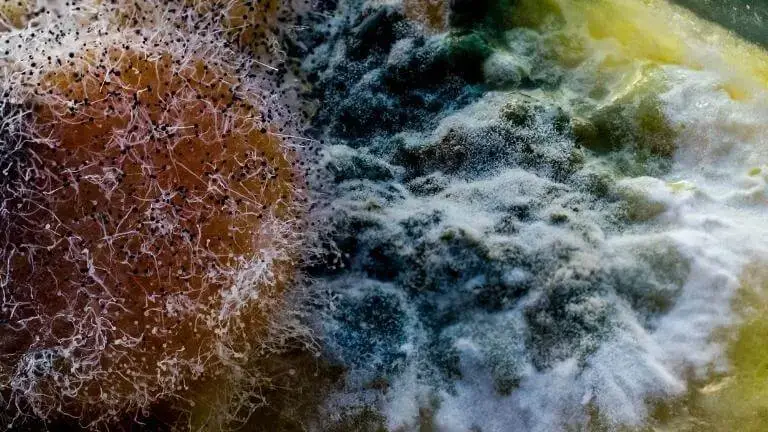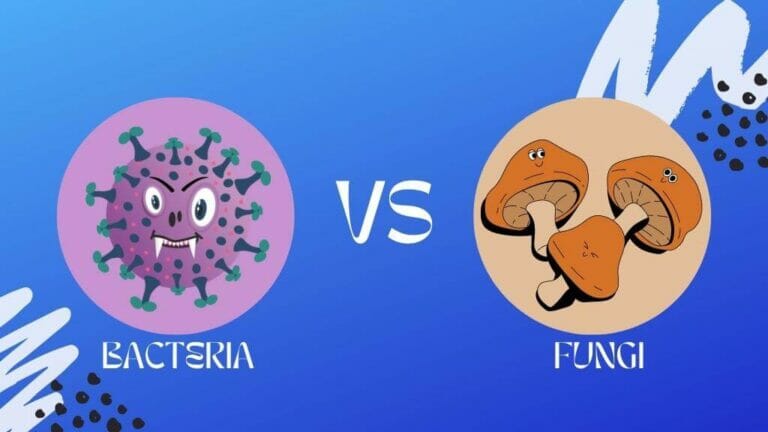The major difference between bacteria and fungi is that bacteria are made up of prokaryotic cells, while fungi are made up of eukaryotic cells.
Bacteria and fungi are organisms that our naked eyes cannot see. To see these two, we need a microscope.
Thus, these organisms are also known as microscopic organisms.
The bacterial cell wall is composed of one single cell, which is why it is called a unicellular prokaryotic cell. The cell walls of fungi are made up of multiple cells known as multiple eukaryotic cells.
Another key difference between bacteria and fungi is that fungi are heterotrophic organisms, while bacteria are both autotrophic and heterotrophic organisms.
Heterotrophic organisms mean that they rely on other organisms for their food. Autotrophic organisms can make their own food through certain processes.
These organisms cause all kinds of human diseases.
Table of Contents
What are Bacteria?

Bacteria are the smallest form of living organisms. They are tiny, unicellular organisms that are at the basic stages of development.
They consist of one single cell, known as a unicellular prokaryotic cell. The vast majority of bacteria do not harm humans. However, some of them can spread disease.
They are found in billions on the earth, both within and outside living organisms.
One single bacteria is called a bacterium, while multiple bacteria are known as bacteria.
Bacteria are small species belonging to the Kingdom Monera. Five kingdoms are used to categorize living creatures. Kingdom Monera is one of them.
Characteristics of Bacteria

The important characteristics of bacteria are given below:
- The size of bacteria can be 0.2nm.
- Bacteria lack several cellular components, such as nuclei.
- Bacteria are composed of one single cell.
- Bacterial cell walls are made up of stiff materials called peptidoglycan.
- Some bacteria can move more easily because they have projections like flagella.
- For bacteria, binary fission is the most typical asexual reproduction process.
- Some bacteria reproduce by sexual reproduction, known as conjugation.
Types of Bacteria

There are five main varieties of bacteria based on their shapes.
- Spherical bacteria
They are spherical round shapes, also known as cocci.
- Bacilli bacteria
Bacilli are found in a rod shape, also called rod-shaped bacteria.
- Spirilla
They are found in spiral and helical shapes.
- Vibrio
They are found in a comma shape. These bacteria are found in water.
- Spirochetes
These bacteria are found long and corkscrew-shaped.
Uses of Bacteria
- Bacteria are used for producing many drugs for treating diseases, such as antibiotics called Streptomycin.
- Bacteria are also used to make different vaccinations.
- Bacteria also help in the breakdown of organic materials in the soil.
- Bacteria can reproduce different dairy products, such as making yogurt.
What are Fungi?

Fungi are eukaryotic organisms that can be both heterotrophic and non-photosynthetic organisms. They belong to the kingdom of fungi.
Fungi can grow everywhere on the earth and ocean. They are unable to produce food on their own. Fungi need to obtain their nutrition from a host to survive.
Many of the foods that we relish, including bakery items and cheese, are all a gift of various fungi to us.
Characteristics of Fungi

The important characteristics of fungi are given below:
- Fungi are microscopic organisms.
- Fungi reproduce by means of spores.
- Chitin is the part of the cell wall in fungi.
- Fungi take up nutrients through absorption.
- Yeasts, molds, and mushrooms are some examples of fungi.
Uses of Fungi
- There is a great role of fungi in the brewing industry.
- The most widely used medicine “Penicillium,” is made with fungi.
- Mushrooms and other fungi are edible sources of nutrition.
- They are also used to make organic compounds and bio fertilizers.
Difference Between Bacteria and Fungi in Terms of Diseases
The difference between fungi and bacteria in terms of diseases is that bacteria cause a wide range of human diseases, and such bacteria are called pathogenic bacteria.
While fungi can cause human diseases, they can also affect plants.
Tuberculosis (TB), which severely affects the lungs, is among the most serious diseases caused by bacteria. On the other hand, fungi can lead to human diseases such as ringworm.
Mycobacterium is the main cause of tuberculosis. These two diseases are rapidly infectious from one human to another human.
Fungi can cause decay to food, such as green molds on bread and rotten potatoes. Bacteria can also cause infection in the eyes and skin.
Fungi can also cause grains to spoil. These are the clear differences between fungi and bacteria, causing serious diseases.
What is the Difference Between Bacteria and Fungi?
The primary difference between fungi and bacteria is that fungi are way larger in size than bacteria. All fungi can either be unicellular or multicellular, while bacteria are multicellular.
Bacteria can be parasitic, where they can infect and live in an organism, and can also be saprophytic when they grow on dead organisms.
Bacteria contain a prokaryotic nucleus, so there is no nuclear membrane or nucleolus. On the other hand, fungi have a well-developed nucleus with a nuclear membrane.
Difference Between Bacteria and Fungi
Highlighting the comparison between fungi and bacteria in the following table:
| Bacteria | Fungi |
| They are prokaryotic organisms. | They are eukaryotic organisms. |
| They do not have any nuclei. | They have a nucleus. |
| They have peptidoglycan as part of their cell wall. | Their cell wall is made up of simple chitin. |
| They have two modes of nutrition, both autotrophic and heterotrophic. | They are heterotrophs. |
| They have flagella for motion. | They are non-motile. |
| Examples of bacteria are Vibrio and Spirilla. | Examples of fungi are Agaraicus and Rhizopus. |
Conclusion
The difference between fungi and bacteria is the arrangement of the cells in each species of organism. Bacteria comprise single cells, whereas fungi comprise multiple cells.
Both bacteria and fungi have the ability to create beneficial medications. Bacteria and fungi work together to decompose dead material and release their nutrients into the soil.


